Cronache
2010: The third ikkyo: aikido between the lamas - In the monastery
Indice articoli
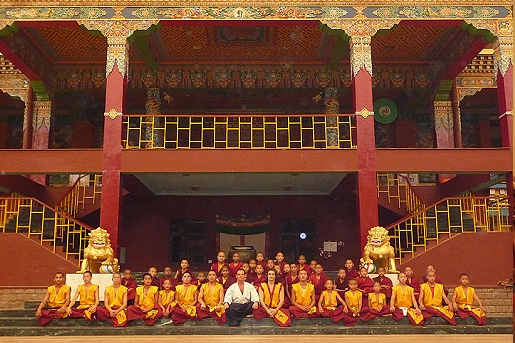 But I realise I have been wittering on for some time now, and not yet accounted for the occurrence of the facts that the photos you see make perfectly plain.
But I realise I have been wittering on for some time now, and not yet accounted for the occurrence of the facts that the photos you see make perfectly plain.
I mean to say, I have not yet explained how it came to pass that I, who am not an eminently meditative aikidoka, should end up in a monastery – not to be initiated to meditation, but to teach the monks my aikido!
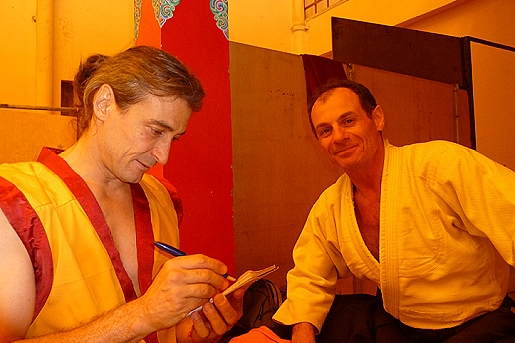 The fact is that as Roberto became ever more integrated with life at the monastery, and in parallel became desirous usefully to contribute to its community; he thus ended up running a martial arts course with the benediction of the Tai Situ himself. Details of this course, which embraces a wide range of disciplines and really is the expression of the many facets of Roberto's expertise, are to be found at the website he created especially to divulge this experience.
The fact is that as Roberto became ever more integrated with life at the monastery, and in parallel became desirous usefully to contribute to its community; he thus ended up running a martial arts course with the benediction of the Tai Situ himself. Details of this course, which embraces a wide range of disciplines and really is the expression of the many facets of Roberto's expertise, are to be found at the website he created especially to divulge this experience.
Roberto is, among other things, a qualified Physical Education teacher. When he was first entrusted with a group of twenty young monks his course was a great success, so that this year his course was reconfirmed – with twice the number of pupils.
During their last stay in Italy, Roberto and Ivana made a stop at my Dojo to tell us of this extraordinary adventure and of the project they're working on. In the end they came up with a suggestion I welcomed, but was yet rather difficult to take up.
India is not exactly round the corner, nor is Tibetan culture the only one to arouse my interest: I'm interested in all cultures, in fact, and my destination for this year were supposed to be the arid landscapes of the Rajastan desert. It so happened, however, that my friend Claudio Cardelli, an expert student of Indian and Tibetan culture, with thirty-three journey to those regions behind him, informed me as I was about to set off of the torrid heat-wave that was then sweeping across India – with over 40° Celsius in Dheli and over 50° in Rajastan! Hardened travellers we are, but not masochistic. So that is how, with a last minute decision, we decided to head northward to the cool of the mountains and go on a trekking trail that would take us to an altitude of 12,000 feet. Having made the latter decision, there was no excuse not to pay our friends a visit: we thus hastily stuffed a keikogi and hakama into our backpacks and off we went.
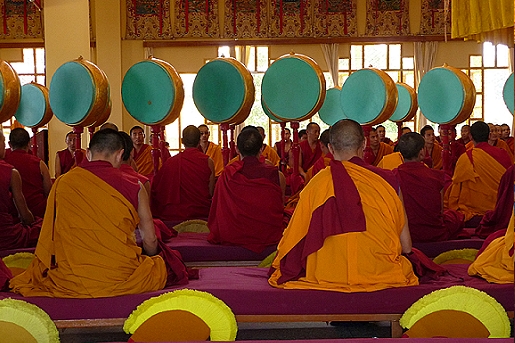 As soon as we reached our destination we had our first stroke of luck: upon arrival at the Palpung Sherabling monastery I enquired after Roberto and Ivana and was guided to a hall full of people where Tai Situ was to hold an audience – the last one before going on a long retreat which was to start only two days later.
As soon as we reached our destination we had our first stroke of luck: upon arrival at the Palpung Sherabling monastery I enquired after Roberto and Ivana and was guided to a hall full of people where Tai Situ was to hold an audience – the last one before going on a long retreat which was to start only two days later.
The audience has just begun and my two friends are indeed the first to be received by Tai Situ in the room reserved for the consultation. Being members of the monastery, they were able to make it so they were the first to be allowed inside. I have to wait a long time – everything in India takes time – and watch closely the various delegations of the faithful who've arrived from all over the world.
The largest delegation comes from Hong Kong: they wear t-shirts of the same deep-red as the monks' robes, with chinese characters printed on them, and as a gift to the monastery they bear a sculpted jade dragon wrapped up in a kata, the ritual white scarf used in Tibet.
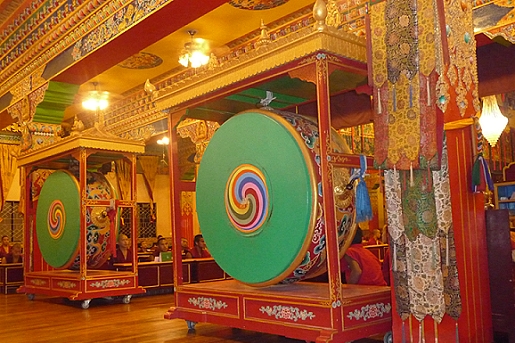 There are groups of western dames with that air about them of the English Romantic gentlewoman; numerous people with the features of the Indian subcontinent, most of whom are clearly Tibetan. I bide my time in conversation with a peculiar youth – born of Austrian father and English mother, and living in Mongolia! He's looking totally spaced, his eyelids heavy and drooping, and generally gives me the notion his search of a higher plane involves not only meditation, but also a set of shortcuts.
There are groups of western dames with that air about them of the English Romantic gentlewoman; numerous people with the features of the Indian subcontinent, most of whom are clearly Tibetan. I bide my time in conversation with a peculiar youth – born of Austrian father and English mother, and living in Mongolia! He's looking totally spaced, his eyelids heavy and drooping, and generally gives me the notion his search of a higher plane involves not only meditation, but also a set of shortcuts.
Our friend are out at long last, and it brings us great joy to see each other in such a special place and so many miles from home. Roberto explains that the opportunity really is not to be missed, so we persist in the long queue and finally are admitted to a brief audience with the Tai Situ – a figure whose standing in that culture might be compared to what the Pope is to a Catholic. Roberto introduces me as his Aikido teacher, and suggests that for a few days I be entrusted with the pupils who attend his habitual three-hour classes. The simplicity and cordiality of the Tai Situ impress me greatly, and bring back to me the complex of emotions I felt upon meeting the Aikido Doshu face to face at the Tokyo Hombu Dojo.
This utter simplicity of behaviour, and the capacity to make the highness of their rank not burdensome to their interlocutor must be a prorogative of the truly great: it is the very simplicity of the exchange that made it a magical and intensely stirring occasion. Having had the Kata placed around my neck as a blessing and salute, I take my leave in a state of mild confusion. Is it true, then? I shall be teaching at the dojo in the monastery on the morrow! We are then accompanied to our rooms at the recently built monastery guest house, and immediately set out on an exploration of its buildings. The most impressive space is the ample covered court fronting the temple.
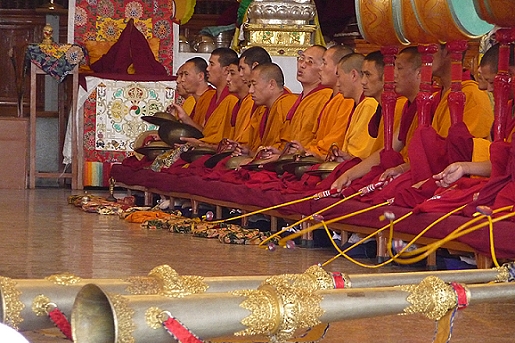 All along the other three sides of the court are the monks' lodgings and study rooms, and the physical space of the court acts as resonator to the chants the monks intone, resonating constantly in the varied registers of the monks – from the high pitches of the very young to the incredible bass notes of the elders.
All along the other three sides of the court are the monks' lodgings and study rooms, and the physical space of the court acts as resonator to the chants the monks intone, resonating constantly in the varied registers of the monks – from the high pitches of the very young to the incredible bass notes of the elders.
Drums, bell, the deep lowing of the long horn instruments which announce the start of a function, the incessant to and fro of monks clad in red and yellow... the place really seems to stand outside reality.

